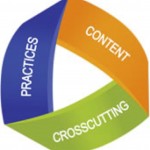You may remember from previous posts that I work with the MPRES grant as the science  education consultant. The goal of the grant is to prepare a group of teachers who are qualified to provide professional development to teachers of science related to the Framework and the Next Generation Science Standards. Our work in the grant has resulted in the creation of a Toolkit for professional development outlined in a previous post. As I reflect on what the dimensions of the Framework will look like in practice, I was reminded of the field trips I took to Yellowstone Park with middle school students. For 30 years, I took 7th grade students to the Park in the fall. The trip had a outdoor school emphasis, but included investigations of the geothermal features. After the 1988 fires, we conducted fire regrowth research in the same area every year. The students measured the percentage coverage of plants on the forest floor, measured the heights of grasses and trees. The data was compiled and the analyzed against previous years’ data. This is an example of how students engage in the Science & Engineering (S & E) Practice of Analyzing and Interpreting Data. Through the process, they were involved in the Practice of Asking Questions. In addition, they conducted yearly water quality studies on both the Firehole and Gibbon Rivers, measuring biological index factors such as water temperature, pH, dissolved oxygen, carbon dioxide and stream flow rates. Back in the classroom, the Constructed Explanations of the data, another S & E Practice. When working with the numerical data sets they were Using Mathematics and Computational Thinking. As a culminating activity, students were placed in groups for the purpose of Obtaining, Evaluating and Communicating information about the trip by writing webpages. Each group was responsible for a different aspect of the field trip. Another dimension of the Framework, Crosscutting Concepts, were also evident in the students’ work. Over the years, they could witness Stability and Change as they analyzed the data sets. A similar process was repeated in the 8th grade on a spring field trip with emphasis on the geology of the Park. The students also created webpages after the experience.As teachers are challenged to begin the implementation of the dimensions of the Framework and NGSS, I encourage them to think about ways they are already using many of the S & E Practices and Crosscutting Concepts. An honest personal reflection of current practice, especially when conducted in professional learning communities (PLCs), will yield many instructional strategies that current match the Framework. If you are new to teaching or simply don’t know where to start with the emerging NGSS expectations, I strongly suggest, as do many others, that you begin with the Framework dimension of Science & Engineering Practices. As illustrated here, many teachers will discover that they are already doing many of the practices.
education consultant. The goal of the grant is to prepare a group of teachers who are qualified to provide professional development to teachers of science related to the Framework and the Next Generation Science Standards. Our work in the grant has resulted in the creation of a Toolkit for professional development outlined in a previous post. As I reflect on what the dimensions of the Framework will look like in practice, I was reminded of the field trips I took to Yellowstone Park with middle school students. For 30 years, I took 7th grade students to the Park in the fall. The trip had a outdoor school emphasis, but included investigations of the geothermal features. After the 1988 fires, we conducted fire regrowth research in the same area every year. The students measured the percentage coverage of plants on the forest floor, measured the heights of grasses and trees. The data was compiled and the analyzed against previous years’ data. This is an example of how students engage in the Science & Engineering (S & E) Practice of Analyzing and Interpreting Data. Through the process, they were involved in the Practice of Asking Questions. In addition, they conducted yearly water quality studies on both the Firehole and Gibbon Rivers, measuring biological index factors such as water temperature, pH, dissolved oxygen, carbon dioxide and stream flow rates. Back in the classroom, the Constructed Explanations of the data, another S & E Practice. When working with the numerical data sets they were Using Mathematics and Computational Thinking. As a culminating activity, students were placed in groups for the purpose of Obtaining, Evaluating and Communicating information about the trip by writing webpages. Each group was responsible for a different aspect of the field trip. Another dimension of the Framework, Crosscutting Concepts, were also evident in the students’ work. Over the years, they could witness Stability and Change as they analyzed the data sets. A similar process was repeated in the 8th grade on a spring field trip with emphasis on the geology of the Park. The students also created webpages after the experience.As teachers are challenged to begin the implementation of the dimensions of the Framework and NGSS, I encourage them to think about ways they are already using many of the S & E Practices and Crosscutting Concepts. An honest personal reflection of current practice, especially when conducted in professional learning communities (PLCs), will yield many instructional strategies that current match the Framework. If you are new to teaching or simply don’t know where to start with the emerging NGSS expectations, I strongly suggest, as do many others, that you begin with the Framework dimension of Science & Engineering Practices. As illustrated here, many teachers will discover that they are already doing many of the practices.
Engaging Students in the Science & Engineering Practices
This entry was posted in Blog Posts. Bookmark the permalink.
